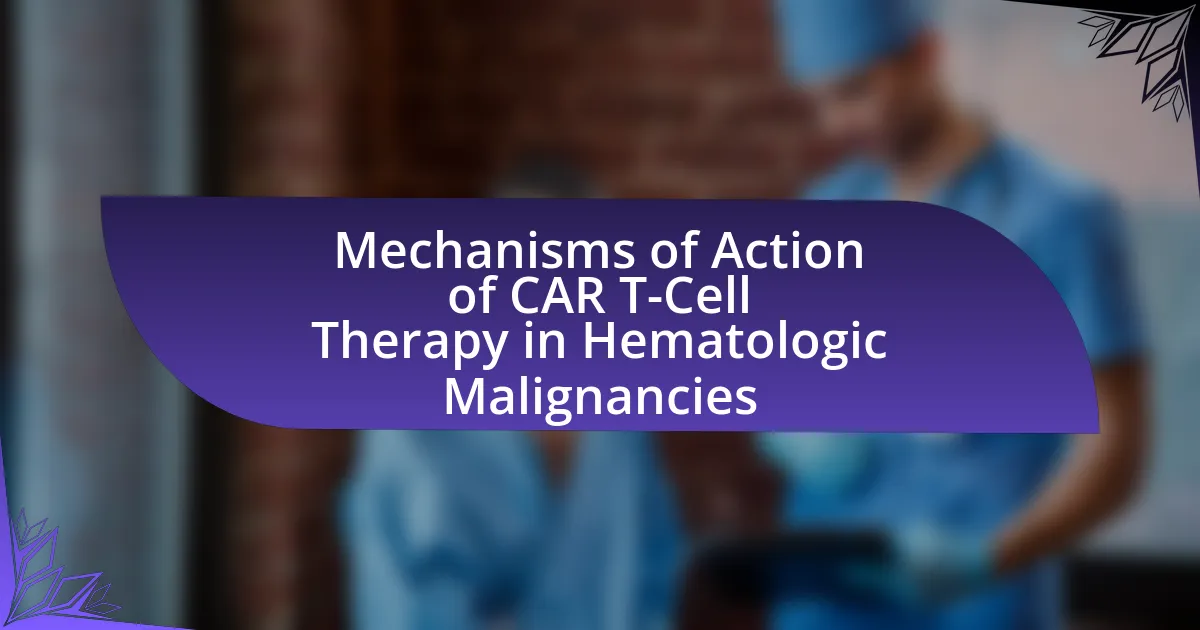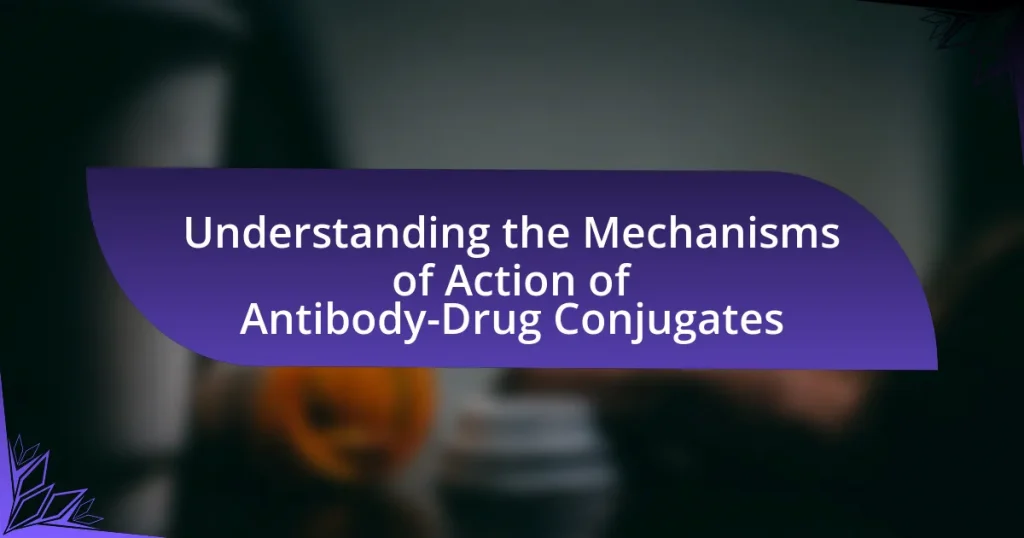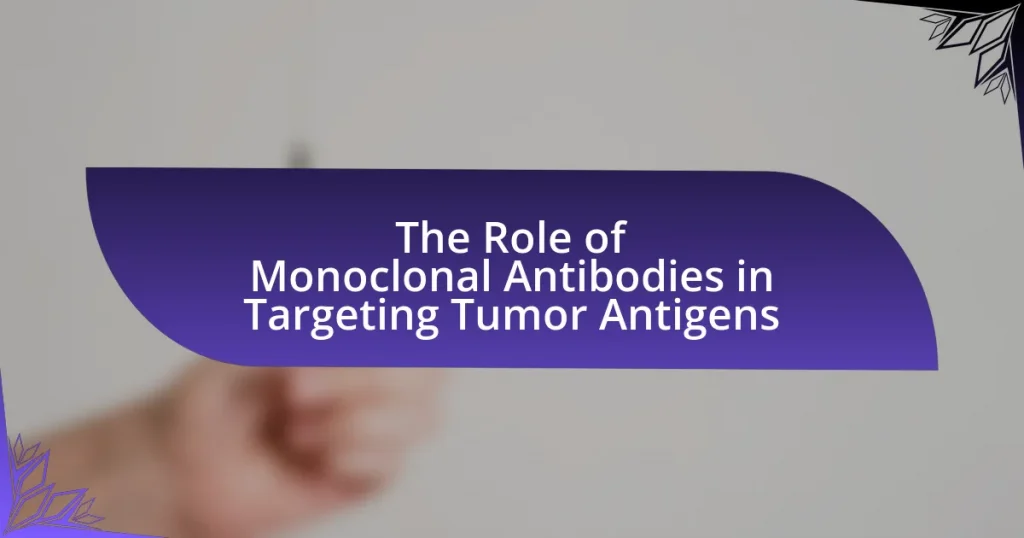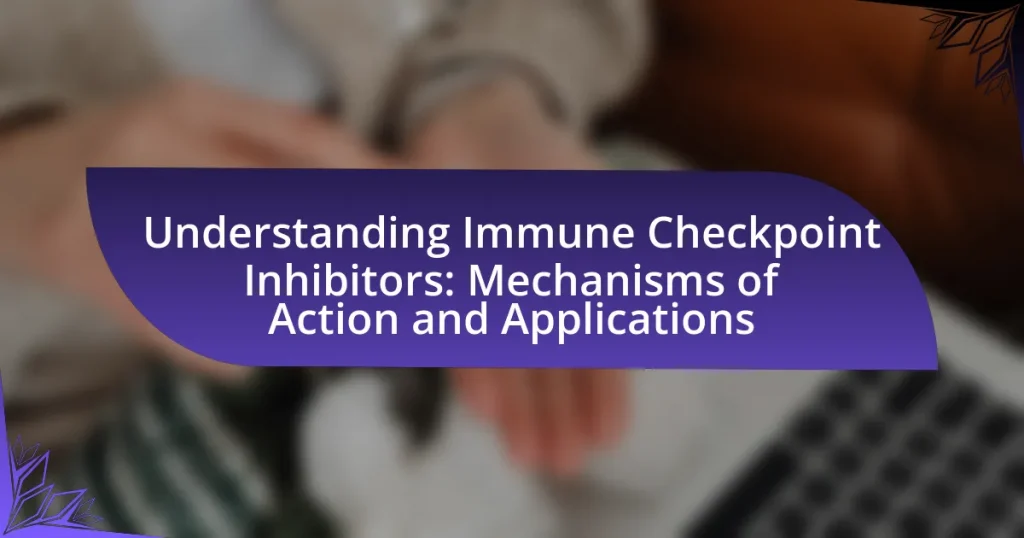CAR T-cell therapy is a groundbreaking treatment for hematologic malignancies that involves the genetic modification of a patient’s T-cells to express chimeric antigen receptors (CARs), enabling them to target specific cancer antigens. The article outlines the mechanisms of action of CAR T-cell therapy, detailing the processes of T-cell extraction, genetic engineering, and reinfusion, as well as the critical phases involved in treatment. It also addresses how CAR T-cells differentiate between healthy and malignant cells, the challenges and limitations of the therapy, and the future directions for enhancing its efficacy and safety. Key factors influencing treatment outcomes, including tumor microenvironment and antigen heterogeneity, are discussed, alongside best practices for patient selection and management of side effects.
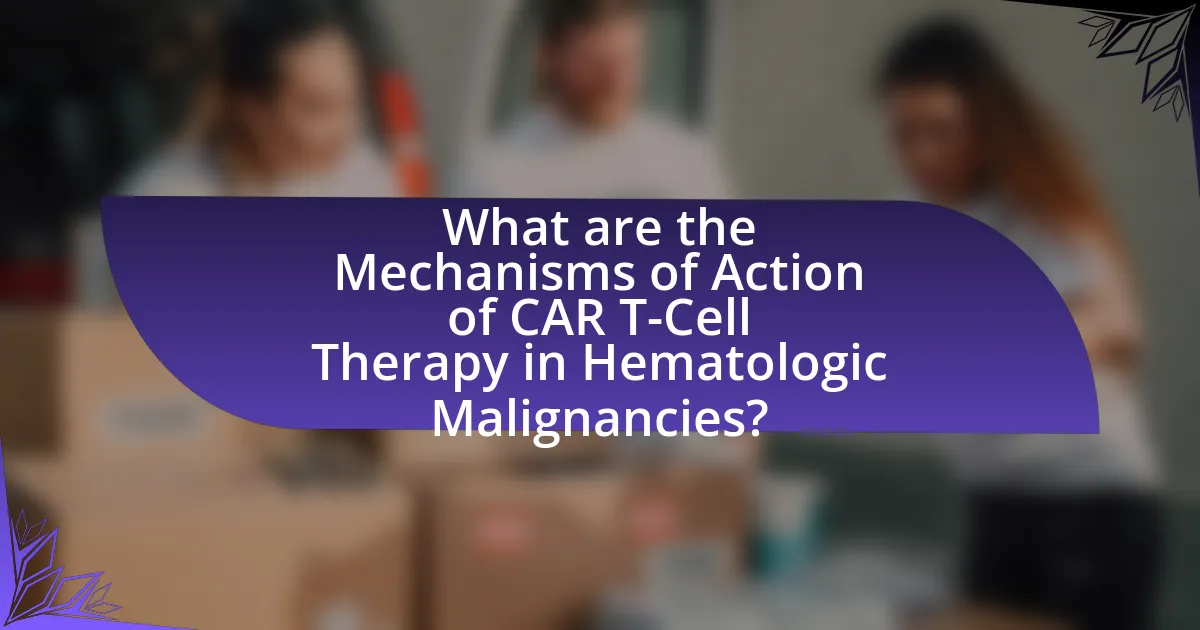
What are the Mechanisms of Action of CAR T-Cell Therapy in Hematologic Malignancies?
CAR T-cell therapy operates through the genetic modification of a patient’s T-cells to express chimeric antigen receptors (CARs) that specifically target antigens on hematologic malignancies. This process begins with the extraction of T-cells from the patient, which are then engineered in the laboratory to recognize specific tumor-associated antigens, such as CD19 in B-cell malignancies. Once reintroduced into the patient, these CAR T-cells proliferate and mount an immune response against the cancer cells, leading to their destruction. Clinical studies have demonstrated significant efficacy, with CAR T-cell therapies achieving remission rates of over 80% in certain hematologic cancers, such as acute lymphoblastic leukemia and diffuse large B-cell lymphoma.
How do CAR T-cells recognize and target cancer cells?
CAR T-cells recognize and target cancer cells through engineered receptors known as chimeric antigen receptors (CARs) that specifically bind to antigens present on the surface of tumor cells. These CARs are designed to identify unique proteins, such as CD19, which is commonly found on B-cell malignancies. Upon binding to these antigens, CAR T-cells become activated, proliferate, and initiate a cytotoxic response against the cancer cells, leading to their destruction. This mechanism has been validated in clinical settings, where CAR T-cell therapies have shown significant efficacy in treating hematologic malignancies, evidenced by substantial remission rates in patients with conditions like acute lymphoblastic leukemia and certain types of lymphoma.
What role do chimeric antigen receptors (CARs) play in this process?
Chimeric antigen receptors (CARs) are engineered proteins that enable T-cells to recognize and attack cancer cells in hematologic malignancies. By incorporating specific antigen recognition domains, CARs allow T-cells to identify and bind to tumor-associated antigens, leading to targeted destruction of malignant cells. This mechanism enhances the T-cells’ ability to proliferate and exert cytotoxic effects against the cancer, significantly improving therapeutic outcomes in patients with blood cancers such as leukemia and lymphoma. Studies have shown that CAR T-cell therapy can lead to complete remission in a substantial percentage of patients, demonstrating the effectiveness of CARs in this therapeutic context.
How do CAR T-cells differentiate between healthy and malignant cells?
CAR T-cells differentiate between healthy and malignant cells primarily through the recognition of specific antigens present on the surface of the cells. These engineered T-cells are designed to express chimeric antigen receptors (CARs) that specifically bind to tumor-associated antigens, which are often overexpressed or uniquely expressed on malignant cells compared to healthy cells. For example, the CD19 antigen is commonly targeted in B-cell malignancies, as it is present on malignant B-cells but not on most normal tissues. This selective binding allows CAR T-cells to activate and proliferate in response to malignant cells while sparing healthy cells, thereby minimizing damage to normal tissues.
What is the process of CAR T-cell production?
The process of CAR T-cell production involves several key steps: first, T-cells are collected from a patient’s blood through a procedure called leukapheresis. Next, these T-cells are genetically modified in a laboratory to express chimeric antigen receptors (CARs) that target specific cancer cells. After modification, the CAR T-cells are expanded in culture to increase their numbers. Finally, the engineered CAR T-cells are infused back into the patient, where they can recognize and attack cancer cells. This method has been validated by clinical trials demonstrating its efficacy in treating hematologic malignancies, such as certain types of leukemia and lymphoma.
How are T-cells harvested from patients?
T-cells are harvested from patients through a process called leukapheresis. During leukapheresis, blood is drawn from the patient, and a machine separates the T-cells from other blood components. The collected T-cells are then preserved for further processing, such as genetic modification for CAR T-cell therapy. This method is validated by its widespread use in clinical settings, demonstrating its effectiveness in obtaining a sufficient quantity of T-cells for therapeutic applications.
What steps are involved in engineering T-cells to express CARs?
The steps involved in engineering T-cells to express CARs include T-cell isolation, transduction with a CAR-encoding vector, expansion of the modified T-cells, and quality control before infusion. First, T-cells are isolated from a patient’s blood using leukapheresis. Next, these T-cells are transduced with a viral or non-viral vector that carries the gene encoding the chimeric antigen receptor (CAR). Following transduction, the modified T-cells are expanded in culture to increase their numbers. Finally, quality control measures are implemented to ensure the safety and efficacy of the engineered T-cells before they are infused back into the patient. These steps are critical for the successful application of CAR T-cell therapy in treating hematologic malignancies.
What are the key phases of CAR T-cell therapy in treatment?
The key phases of CAR T-cell therapy in treatment are patient preparation, T-cell collection, genetic modification, T-cell expansion, and reinfusion. During patient preparation, the patient undergoes lymphodepletion to enhance the efficacy of the therapy. T-cell collection involves harvesting T-cells from the patient’s blood. In the genetic modification phase, these T-cells are engineered to express chimeric antigen receptors (CARs) that target specific cancer cells. Following this, T-cell expansion occurs, where the modified T-cells are multiplied in the laboratory to achieve a sufficient quantity. Finally, the reinfusion phase involves administering the expanded CAR T-cells back into the patient to attack the cancer. Each of these phases is critical for the successful application of CAR T-cell therapy in treating hematologic malignancies.
What happens during the lymphodepletion phase?
During the lymphodepletion phase, the patient’s existing lymphocytes are significantly reduced through chemotherapy or radiation therapy. This reduction creates a favorable environment for the infused CAR T-cells by decreasing competition for resources and allowing for enhanced expansion and persistence of the CAR T-cells. Studies have shown that lymphodepletion can improve the efficacy of CAR T-cell therapy by facilitating better engraftment and activation of the therapeutic cells, ultimately leading to improved clinical outcomes in patients with hematologic malignancies.
How do CAR T-cells expand and persist in the body after infusion?
CAR T-cells expand and persist in the body after infusion primarily through clonal proliferation and the establishment of memory T-cell populations. Following infusion, CAR T-cells recognize and bind to specific antigens on tumor cells, leading to their activation. This activation triggers a robust proliferation of CAR T-cells, which can result in a significant increase in their numbers within the body. Studies have shown that the persistence of CAR T-cells is influenced by factors such as the initial dose, the presence of supportive cytokines, and the tumor microenvironment. For instance, research indicates that CAR T-cells can remain detectable in patients for years post-infusion, contributing to long-term remission in some cases of hematologic malignancies.
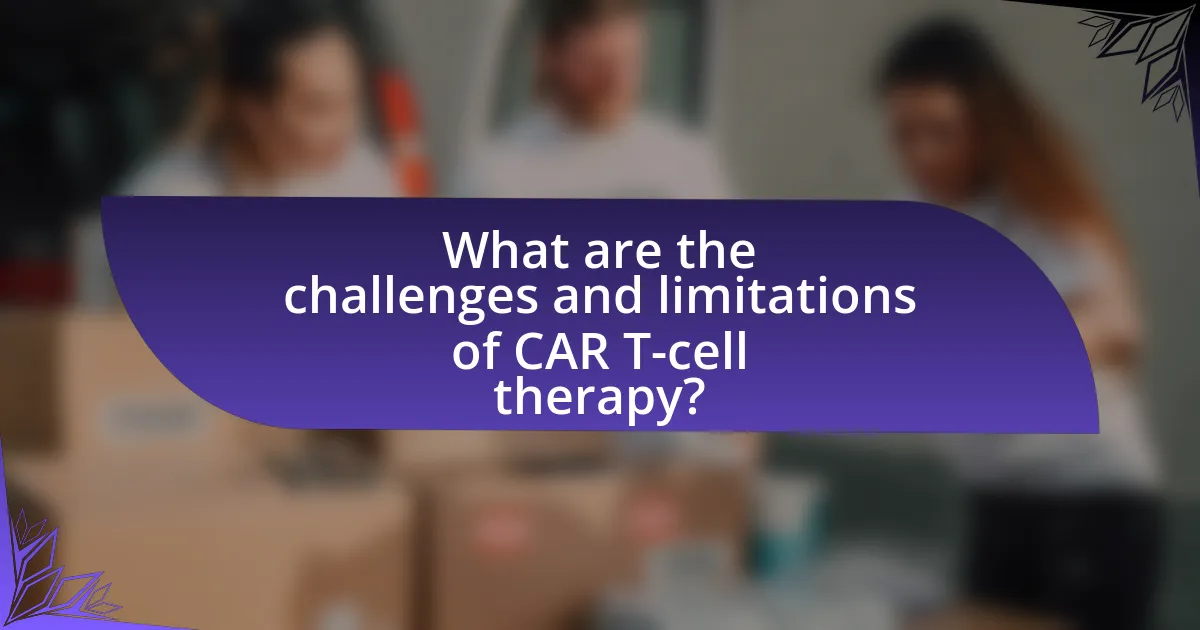
What are the challenges and limitations of CAR T-cell therapy?
CAR T-cell therapy faces several challenges and limitations, including severe side effects, high costs, and limited effectiveness against certain cancers. Severe side effects, such as cytokine release syndrome and neurotoxicity, can occur in a significant number of patients, impacting their overall health and treatment outcomes. The high cost of CAR T-cell therapy, often exceeding $373,000 per patient, limits accessibility for many individuals. Additionally, the therapy may not be effective for all types of hematologic malignancies, particularly solid tumors, due to factors like the tumor microenvironment and antigen heterogeneity. These challenges underscore the need for ongoing research to improve the safety, efficacy, and affordability of CAR T-cell therapies.
What are the common side effects associated with CAR T-cell therapy?
Common side effects associated with CAR T-cell therapy include cytokine release syndrome (CRS), neurotoxicity, fever, fatigue, and low blood cell counts. CRS occurs in a significant number of patients, with symptoms ranging from mild flu-like signs to severe complications, affecting approximately 70-90% of treated individuals. Neurotoxicity can manifest as confusion, seizures, or difficulty speaking, impacting around 20-40% of patients. Additionally, patients often experience fatigue and low blood cell counts, which can lead to increased risk of infections and anemia. These side effects are well-documented in clinical studies, highlighting the importance of monitoring and managing them during treatment.
How does cytokine release syndrome (CRS) manifest in patients?
Cytokine release syndrome (CRS) manifests in patients primarily through symptoms such as fever, fatigue, nausea, headache, and myalgia. These symptoms occur due to the rapid release of pro-inflammatory cytokines into the bloodstream following therapies like CAR T-cell therapy. In severe cases, CRS can lead to more serious complications, including hypotension, hypoxia, and multi-organ dysfunction, which are associated with elevated levels of cytokines such as interleukin-6 (IL-6) and interferon-gamma (IFN-γ). Studies have shown that the severity of CRS correlates with the degree of T-cell activation and the subsequent cytokine release, highlighting the importance of monitoring these manifestations in patients undergoing CAR T-cell therapy.
What neurological toxicities can arise from CAR T-cell therapy?
Neurological toxicities that can arise from CAR T-cell therapy include cytokine release syndrome (CRS), neurotoxicity, and encephalopathy. CRS can lead to symptoms such as confusion, seizures, and altered mental status due to the release of inflammatory cytokines. Neurotoxicity, often referred to as CAR T-cell-related encephalopathy syndrome (CRES), can manifest as headaches, tremors, and aphasia. Studies have shown that these toxicities are dose-dependent and can occur in up to 30-50% of patients receiving CAR T-cell therapy, highlighting the need for careful monitoring and management of neurological symptoms during treatment.
What factors influence the effectiveness of CAR T-cell therapy?
The effectiveness of CAR T-cell therapy is influenced by several key factors, including the type of cancer being treated, the characteristics of the CAR T-cells, the patient’s immune system, and the tumor microenvironment. Specific cancers, such as certain types of leukemia and lymphoma, respond better to CAR T-cell therapy due to the presence of targetable antigens. The design and specificity of the CAR T-cells, including their affinity for the target antigen and the co-stimulatory signals they provide, also play a crucial role in their effectiveness. Additionally, the patient’s overall health and immune status can impact the therapy’s success, as a compromised immune system may hinder the CAR T-cells’ ability to proliferate and function. Lastly, the tumor microenvironment, which can be immunosuppressive, may limit the efficacy of CAR T-cells by creating barriers to their activity.
How does tumor microenvironment affect CAR T-cell function?
The tumor microenvironment significantly impairs CAR T-cell function by creating immunosuppressive conditions that inhibit T-cell activation and persistence. Factors such as the presence of regulatory T cells, myeloid-derived suppressor cells, and various cytokines contribute to this suppression, leading to reduced efficacy of CAR T-cell therapies. For instance, studies have shown that high levels of transforming growth factor-beta (TGF-β) in the tumor microenvironment can inhibit CAR T-cell proliferation and function, ultimately diminishing their ability to target and eliminate tumor cells.
What role does antigen heterogeneity play in treatment outcomes?
Antigen heterogeneity significantly impacts treatment outcomes in CAR T-cell therapy for hematologic malignancies by influencing the effectiveness of the therapy against tumor cells. Variability in antigen expression on cancer cells can lead to incomplete targeting by CAR T-cells, resulting in tumor escape and relapse. Studies have shown that tumors with diverse antigen profiles can evade immune detection, as seen in cases where CD19-negative relapses occur after initial CD19-targeted CAR T-cell therapy. This highlights the necessity for strategies that address antigen heterogeneity to improve the durability of treatment responses and overall patient outcomes.
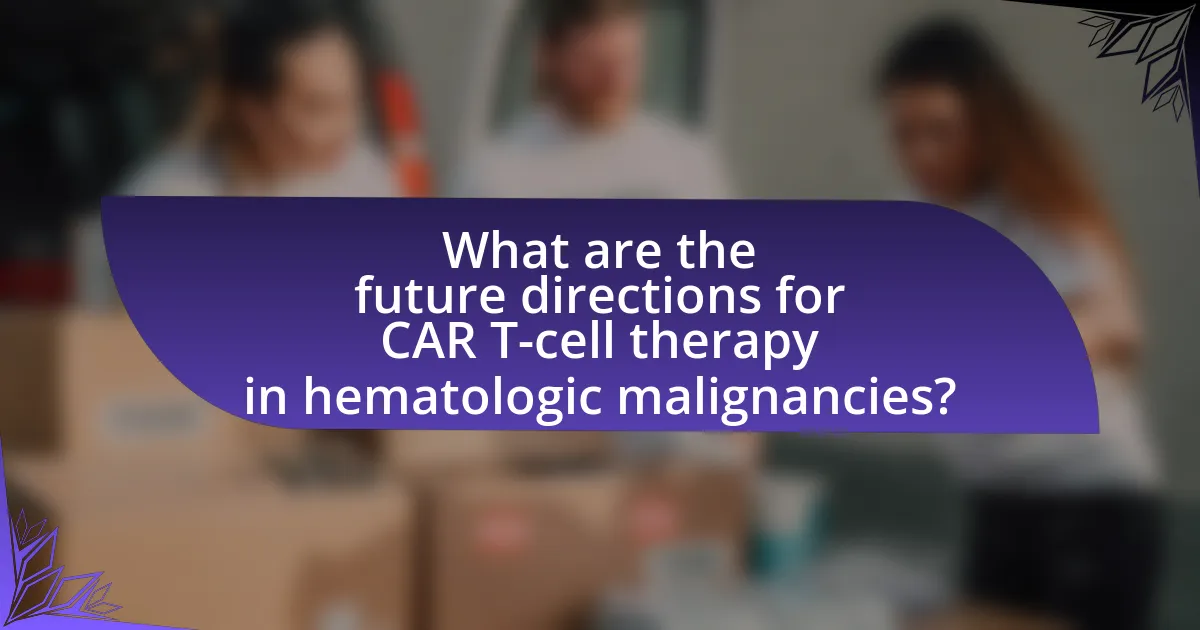
What are the future directions for CAR T-cell therapy in hematologic malignancies?
Future directions for CAR T-cell therapy in hematologic malignancies include the development of next-generation CAR T-cells with enhanced efficacy and safety profiles, such as dual-targeting CARs and armored CARs that can secrete cytokines to improve anti-tumor responses. Research is also focusing on overcoming resistance mechanisms, such as tumor microenvironment modulation and the use of combination therapies with checkpoint inhibitors or other immunotherapies. Clinical trials are underway to evaluate these innovative approaches, aiming to expand the applicability of CAR T-cell therapy to a broader range of hematologic cancers and improve outcomes for patients.
How are researchers addressing the limitations of current CAR T-cell therapies?
Researchers are addressing the limitations of current CAR T-cell therapies by developing next-generation CAR constructs that enhance efficacy and reduce toxicity. These advancements include the incorporation of dual-targeting strategies, which allow CAR T-cells to recognize multiple antigens on tumor cells, thereby minimizing the risk of tumor escape. Additionally, researchers are exploring the use of safety switches that can deactivate CAR T-cells in case of severe adverse effects, improving patient safety. Clinical trials have shown that these modifications can lead to improved response rates and reduced side effects, demonstrating their potential to overcome existing challenges in CAR T-cell therapy.
What advancements are being made in CAR design and engineering?
Advancements in CAR design and engineering include the development of next-generation CAR T-cell therapies that enhance efficacy and reduce side effects. Innovations such as dual-targeting CARs, which can recognize multiple antigens, improve specificity and reduce the risk of tumor escape. Additionally, the incorporation of safety switches allows for the controlled elimination of CAR T-cells in case of severe adverse reactions. Research has shown that these advancements lead to improved patient outcomes, as evidenced by clinical trials demonstrating higher response rates and lower toxicity profiles in hematologic malignancies.
How might combination therapies enhance CAR T-cell effectiveness?
Combination therapies can enhance CAR T-cell effectiveness by addressing tumor microenvironment challenges and improving T-cell persistence. For instance, combining CAR T-cell therapy with immune checkpoint inhibitors can reduce the inhibitory signals that suppress T-cell activity, thereby increasing the efficacy of the CAR T-cells. Studies have shown that such combinations can lead to improved response rates in patients with hematologic malignancies, as evidenced by clinical trials demonstrating enhanced overall survival and remission rates when CAR T-cells are administered alongside agents like pembrolizumab or nivolumab. This synergistic approach not only boosts the anti-tumor response but also helps in overcoming resistance mechanisms that tumors may employ against CAR T-cell therapies.
What practical considerations should clinicians keep in mind when using CAR T-cell therapy?
Clinicians should consider patient eligibility, potential side effects, and the need for close monitoring when using CAR T-cell therapy. Patient eligibility involves assessing factors such as age, overall health, and specific disease characteristics to ensure the therapy is appropriate. Potential side effects, including cytokine release syndrome and neurotoxicity, require clinicians to be prepared for management strategies. Close monitoring is essential during and after treatment to detect and address any adverse effects promptly, as studies indicate that timely intervention can significantly improve patient outcomes.
What are the best practices for patient selection and monitoring?
The best practices for patient selection and monitoring in CAR T-cell therapy involve thorough patient evaluation, including assessing disease characteristics, prior treatments, and overall health status. Selecting patients with specific hematologic malignancies, such as certain types of leukemia or lymphoma, is crucial, as these therapies are designed to target specific antigens present on cancer cells. Monitoring should include regular assessments of treatment response, potential adverse effects, and cytokine release syndrome, which can occur post-infusion. Studies indicate that early identification of complications and timely intervention can significantly improve patient outcomes, reinforcing the importance of structured monitoring protocols.
How can clinicians manage and mitigate side effects effectively?
Clinicians can manage and mitigate side effects effectively by implementing proactive monitoring and supportive care strategies tailored to individual patient needs. This includes regular assessments of vital signs, laboratory tests, and symptom tracking to identify adverse effects early. For instance, the use of tocilizumab has been shown to effectively manage cytokine release syndrome, a common side effect of CAR T-cell therapy, by targeting interleukin-6. Additionally, clinicians can provide supportive medications, such as corticosteroids for severe inflammatory responses, and ensure patient education on recognizing symptoms early. Evidence from clinical trials indicates that these approaches significantly reduce the severity and duration of side effects, enhancing patient outcomes and overall treatment tolerability.
